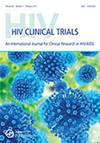Rare emergence of drug resistance in HIV-1 treatment -naïve patients after 48 weeks of treatment with elvitegravir/cobicistat/emtricitabine/tenofovir alafenamide
Q2 Medicine
引用次数: 13
Abstract
Tenofovir alafenamide (TAF), a novel prodrug of the NtRTI tenofovir (TFV), delivers TFV-diphosphate (TFV-DP) to target cells more efficiently than the current prodrug, tenofovir disoproxil fumarate (TDF), with a 90% reduction in TFV plasma exposure. TAF, within the fixed dose combination of elvitegravir /cobicistat / emtricitabine (FTC)/TAF (E/C/F/TAF), has been evaluated in one Phase 2 and two Phase 3 randomized, double-blinded studies in HIV-infected treatment-naive patients, comparing E/C/F/TAF to E/C/F/TDF. In these studies, the TAF-containing group demonstrated non-inferior efficacy to the TDF-containing comparator group with 91.9% of E/C/F/TAF patients having <50 copies/mL of HIV-1 RNA at week 48. An integrated resistance analysis across these three studies was conducted, including HIV-1 genotypic analysis at screening, and genotypic/phenotypic analysis for patients with HIV-1 RNA >400 copies/mL at virologic failure. Pre-existing primary resistance-associated mutations (RAMs) were observed at screening among the 1903 randomized and treated patients: 7.5% had NRTI-RAMs, 18.2% had NNRTI-RAMs, and 3.4% had primary PI-RAMs. Pre-treatment RAMs did not influence treatment response at Week 48. In the E/C/F/TAF group, resistance development was rare; seven patients (0.7%, 7/978) developed NRTI-RAMs, five of whom (0.5%, 5/978) also developed primary INSTI-RAMs. In the E/C/F/TDF group, resistance development was also rare; seven patients (0.8%, 7/925) developed NRTI-RAMs, four of whom (0.4%, 4/925) also developed primary INSTI-RAMs. An additional analysis by deep sequencing in virologic failures revealed minimal differences compared to population sequencing. Overall, resistance development was rare in E/C/F/TAF-treated patients, and the pattern of emergent mutations was similar to E/C/F/TDF.HIV-1治疗中罕见出现耐药性-naïve患者在接受依韦替格拉韦/可比司他/恩曲他滨/替诺福韦阿拉胺治疗48周后
Tenofovir alafenamide (TAF)是NtRTI替诺福韦(TFV)的一种新型前药,它比目前的前药富马酸替诺福韦(TDF)更有效地将tv -二磷酸(tv - dp)递送到靶细胞,可减少90%的TFV血浆暴露。TAF,在elvitegravir /cobicistat / emtricitabine (FTC)/TAF (E/C/F/TAF)的固定剂量组合中,已经在hiv感染的初次治疗患者中进行了一项2期和2项3期随机双盲研究,比较了E/C/F/TAF和E/C/F/TDF。在这些研究中,含TAF组的疗效不逊于含tdf的比较组,91.9%的E/C/F/TAF患者在病毒学失败时为400拷贝/mL。在1903例随机和接受治疗的患者中,筛查时观察到存在原发性耐药相关突变(RAMs): 7.5%患有NRTI-RAMs, 18.2%患有NNRTI-RAMs, 3.4%患有原发性PI-RAMs。在第48周,治疗前RAMs不影响治疗反应。在E/C/F/TAF组中,耐药发生罕见;7例(0.7%,7/978)发生NRTI-RAMs,其中5例(0.5%,5/978)发生原发性inri - rams。在E/C/F/TDF组中,耐药也很少见;7例(0.8%,7/925)患者发生NRTI-RAMs,其中4例(0.4%,4/925)患者同时发生原发性inri - rams。另一项病毒学失败的深度测序分析显示,与群体测序相比,差异很小。总的来说,E/C/F/ taf治疗的患者很少出现耐药性,突发性突变的模式与E/C/F/TDF相似。
本文章由计算机程序翻译,如有差异,请以英文原文为准。
求助全文
约1分钟内获得全文
求助全文
来源期刊

HIV Clinical Trials
医学-传染病学
CiteScore
1.76
自引率
0.00%
发文量
0
审稿时长
>12 weeks
期刊介绍:
HIV Clinical Trials is devoted exclusively to presenting information on the latest developments in HIV/AIDS clinical research. This journal enables readers to obtain the most up-to-date, innovative research from around the world.
 求助内容:
求助内容: 应助结果提醒方式:
应助结果提醒方式:


